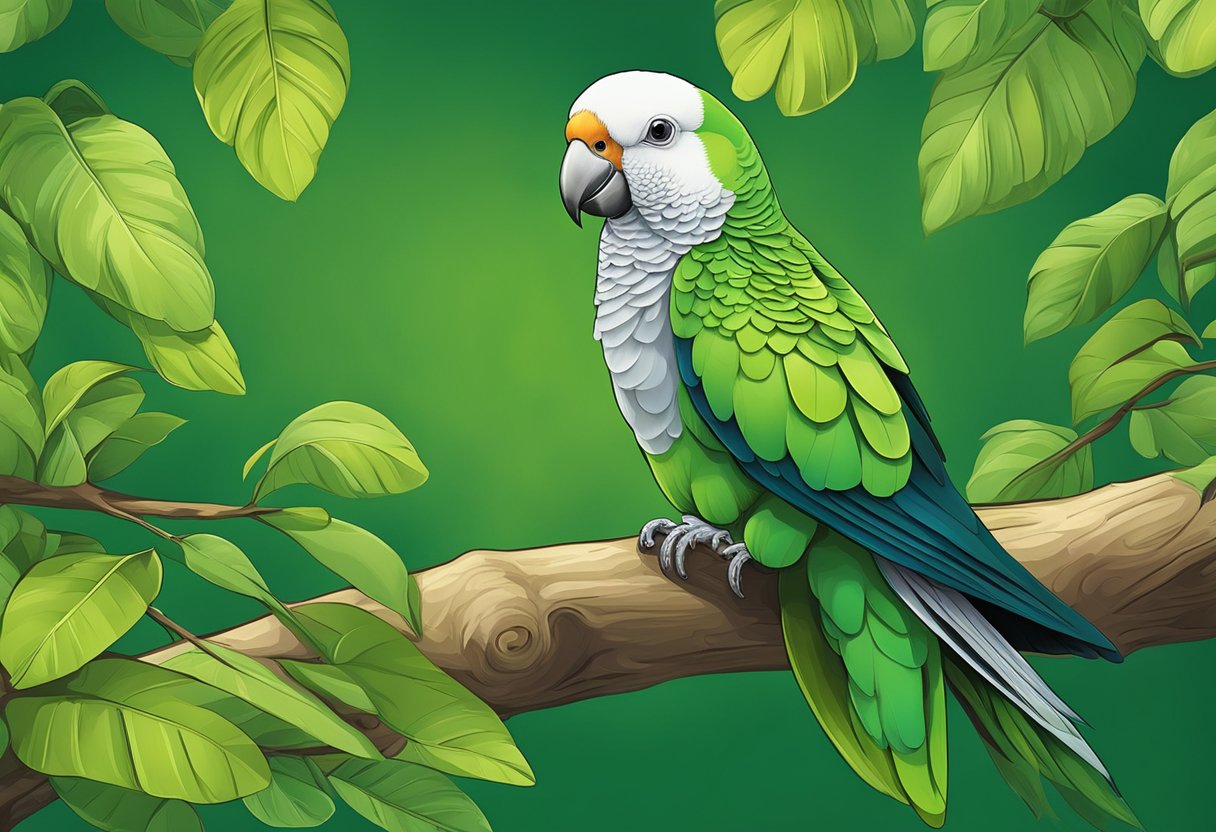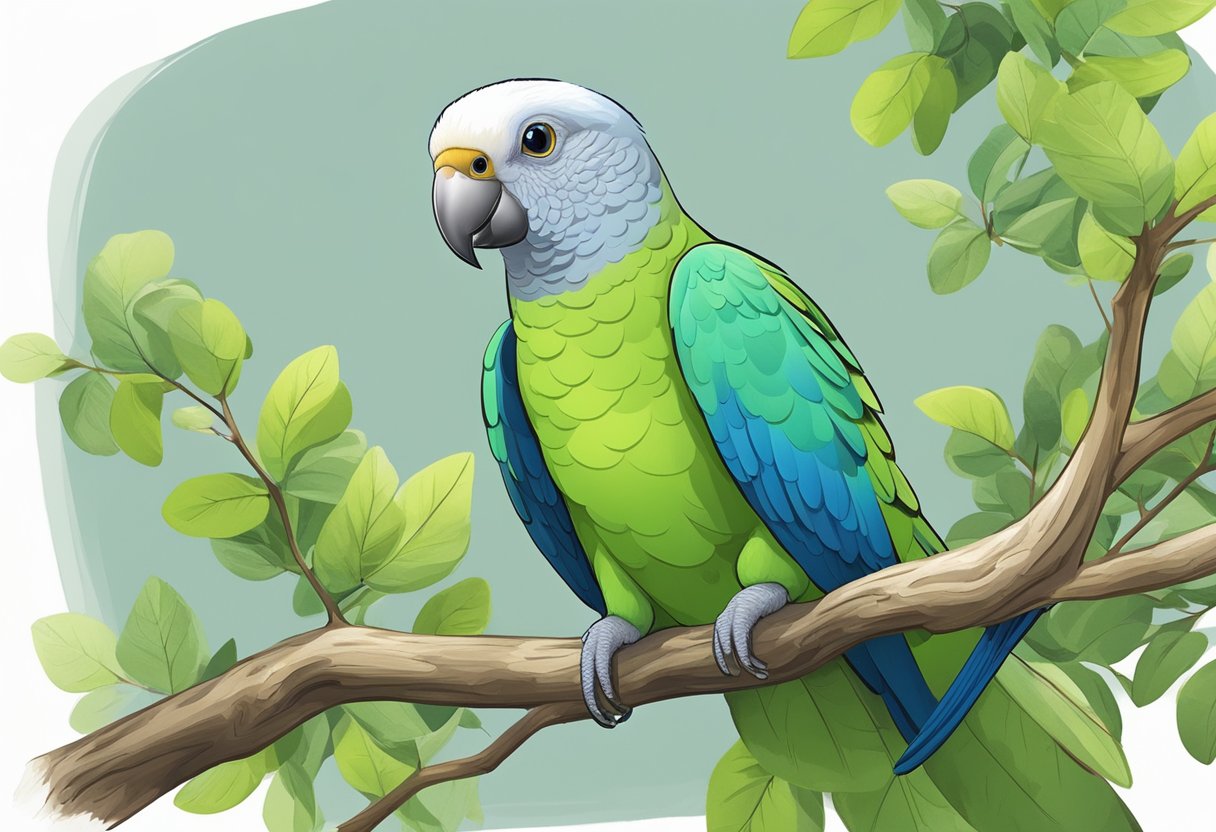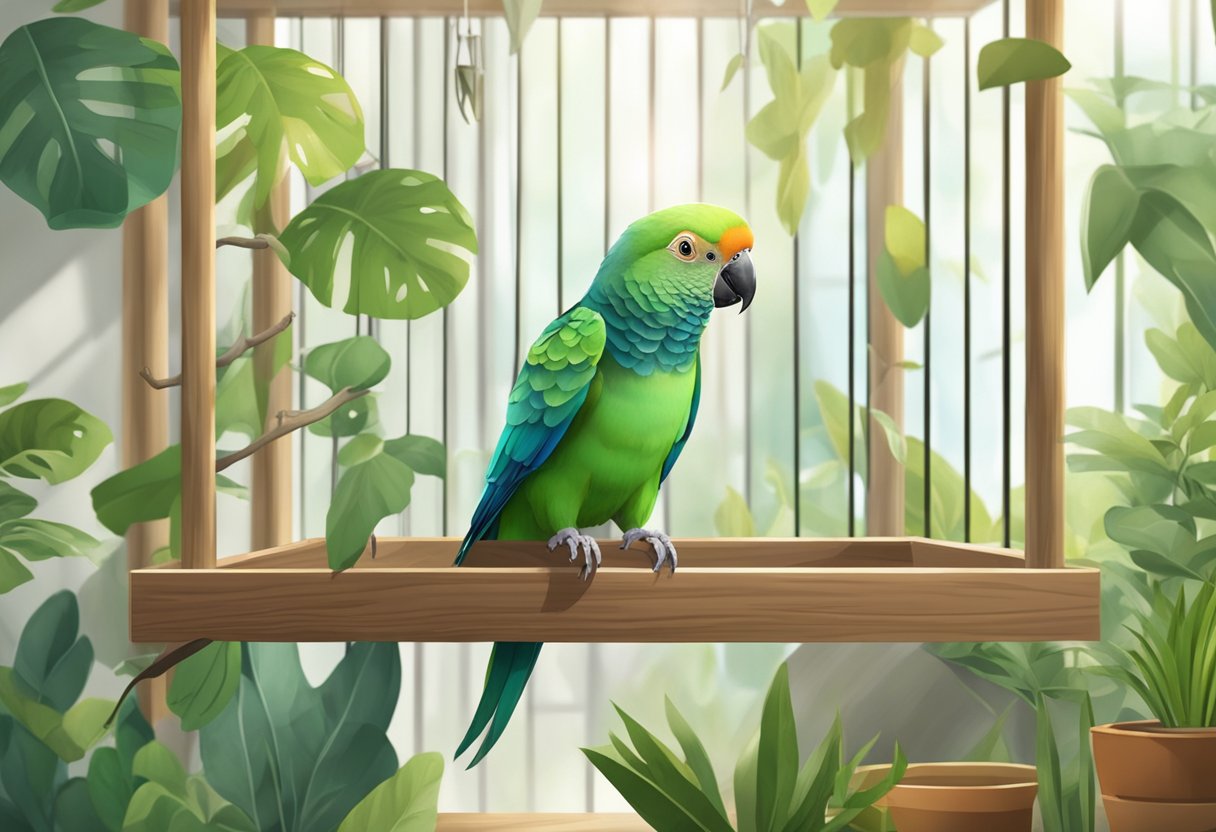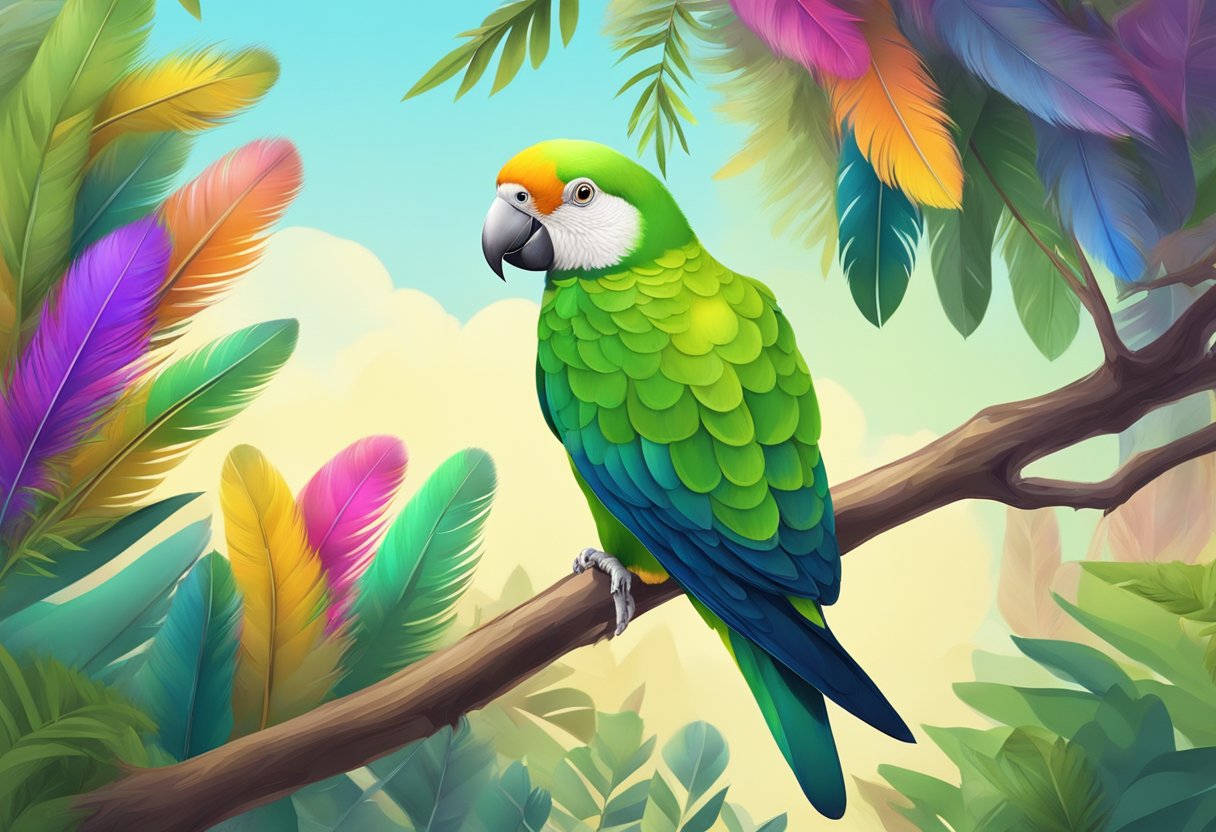Quaker parrots, also known as monk parakeets, are small and charming parrots that are native to South America. They are known for their vibrant green feathers, greyish breast, and greenish-yellow abdomen. These talkative and social birds are popular among pet owners due to their playful nature and ability to mimic human speech.

Quaker parrots have a fascinating history and are one of the few parrot species that builds communal nests. They are intelligent and social birds that thrive in the company of other parrots and humans. Quaker parrots are also known for their ability to learn human speech and mimic sounds, making them a popular choice for pet owners who want an interactive and engaging pet.
Key Takeaways
- Quaker parrots are small and charming parrots that are native to South America.
- They are intelligent and social birds that thrive in the company of other parrots and humans.
- Quaker parrots are known for their ability to learn human speech and mimic sounds, making them a popular choice for pet owners who want an interactive and engaging pet.
Quaker Parrot Origins
Quaker parrots, also known as Monk parakeets, are native to South America, including Argentina, Bolivia, Brazil, and Paraguay. These small parrots are known for their playful nature, comical personalities, and their ability to mimic human speech.
Geographic Distribution
Quaker parrots are found in a variety of habitats, including grasslands, savannas, and forests. They are known to build large communal nests, which can house up to 20 birds. These nests are made of twigs and branches and can be seen in trees, on power lines, and on other man-made structures.
Quaker parrots were first introduced to the United States in the 1960s as a popular pet. Today, they can be found in many parts of the country, including Florida, Texas, and California.
Species Evolution
The scientific name for the Quaker parrot is Myiopsitta monachus. The genus name combines the Ancient Greek mus, muos meaning “mouse” and the Neo-Latin psitta meaning “parrot”, alluding to the mouse-grey face and underparts. The specific epithet monachus Late Latin for a “monk”.
Quaker parrots have a lifespan of 20 to 30 years in captivity, with some even living longer. They have a unique ability to adapt to their environment, which has allowed them to thrive in many different parts of the world.
Overall, the Quaker parrot’s playful nature, intelligence, and adaptability make it a popular pet for many bird enthusiasts.
Physical Characteristics

Quaker parrots, also known as monk parakeets, are small to medium-sized birds that are known for their distinctive green and gray feather coloration. They have a stocky build and a short, rounded tail. Quaker parrots have a lifespan of 20 to 30 years in captivity, but some can live even longer with proper care and attention.
Color Variations
Quaker parrots have a unique feather coloration that is predominantly green with gray on the forehead, cheeks, and throat. They also have blue flight feathers on their wings. However, there are several color variations of Quaker parrots available in the pet trade, including blue, yellow, and albino. These color variations are the result of selective breeding and are not found in the wild.
Size and Anatomy
Quaker parrots are 12 inches in length from beak to tail and weigh between 4 and 5 ounces. They have a robust build and a hooked beak that is used for cracking seeds and nuts. Quaker parrots have zygodactyl feet, which means that two of their toes point forward while the other two point backward. This unique foot structure allows them to climb and grasp objects with ease.
Quaker parrots also have a unique feature called a “crop,” which is a muscular pouch in their neck that is used for storing food before it is digested. This feature is particularly useful in the wild, where Quaker parrots may need to store food for later consumption when resources are scarce.
Overall, Quaker parrots are a fascinating and visually striking bird species that make excellent pets for those willing to provide them with the care and attention they require.
Behavior and Social Structure
Communication
Quaker parrots are known for their ability to mimic human speech, but they also have a variety of other vocalizations that they use to communicate with each other. They use different calls to signal danger, food, and other important information. They also use body language, such as fluffed feathers or raised crests, to convey their emotions.
Flock Dynamics
In the wild, Quaker parrots live in large flocks and have a complex social structure. They form strong bonds with their flock mates and engage in activities such as grooming and preening each other. They also have a hierarchy within the flock, with dominant birds taking the best nesting sites and food sources.
Bonding and Interaction
Quaker parrots are social birds and require interaction with their human caregivers to thrive. They are known for their playful and affectionate personalities, but they can also become aggressive if they feel threatened or stressed. It is important for owners to establish a bond with their Quaker parrot through positive reinforcement training and regular interaction. Providing plenty of toys and activities can also help keep them mentally stimulated and prevent boredom.
Overall, understanding the behavior and social structure of Quaker parrots is essential for providing them with a happy and healthy life in captivity.
Diet and Nutrition
Feeding Habits
Quaker parrots are known for their healthy appetite and can eat a variety of foods in the wild. They feed on seeds, nuts, fruits, berries, leaf buds, and blossoms, and even insects and their larvae. They also like to raid farmers’ crops [1].
In captivity, Quaker parrots require a balanced diet to maintain their health. A good diet for a Quaker parrot should consist of a variety of seeds, pellets, fruits, vegetables, and other nutrient-rich foods [4]. Pellets or complete food should make up 60-80% of their diet, while the remaining should be comprised of fruits, nuts, vegetables, seed, sprouting seed, and other treats that the Quaker parrot likes eating [5].
Nutritional Requirements
Quaker parrots require a balanced diet that provides them with the necessary nutrients to maintain their health. A good diet should include fresh fruits and vegetables, nuts, leafy greens, and healthy table food [1]. The diet should be rich in protein, vitamins, minerals, and fiber.
Quaker parrots require a diet that is low in fat and sugar. High-fat diets can lead to obesity and other health problems, while a diet high in sugar can lead to tooth decay and other dental problems.
It is important to note that Quaker parrots can eat rice, but it should not be given as the sole source of nutrition. It should be fed as part of a balanced diet and in moderation along with other healthy food options [3].
Overall, a balanced and varied diet is essential to maintain the health and well-being of Quaker parrots.
Habitat and Living Conditions

Cage Setup
Quaker parrots are highly social birds and require a spacious cage to live comfortably. A cage with a minimum size of 18 x 18 x 18 inches is recommended for a single bird, but larger cages are always better. The bars should be no wider than 1/2 inch apart to prevent escape or injury. The cage should be made of non-toxic materials and have a secure door.
In addition to the cage, a variety of perches of different sizes and textures should be provided to promote foot health. A shallow dish for food and a water bottle should be placed inside the cage, and they should be cleaned daily. A cuttlebone or mineral block should also be provided to ensure the bird has access to calcium and other essential minerals.
Environmental Enrichment
Quaker parrots are intelligent and curious birds that require plenty of mental stimulation to prevent boredom and associated behavioral problems. Providing a variety of toys, such as chew toys, foraging toys, and puzzle toys, can help keep them entertained. Toys should be rotated regularly to keep the bird interested.
In addition to toys, providing a variety of perches, swings, and ladders can create a stimulating environment for the bird. Natural branches can also be used as perches, but they should be free of pesticides and other harmful chemicals.
Quaker parrots also benefit from social interaction with their owners. Spending time with the bird outside of the cage can provide mental and physical stimulation as well as strengthen the bond between bird and owner.
Overall, providing a spacious cage and a stimulating environment is essential for the health and well-being of Quaker parrots.
Health and Wellness
Common Health Issues
Quaker parrots are generally healthy birds, but they can still experience common health issues. One of the most common issues is feather plucking, which can be caused by parasites or stress. If you notice your Quaker parrot excessively plucking its feathers, it may be a sign of an underlying health issue.
Another common issue is fatty liver disease, which can be caused by a poor diet or lack of exercise. Symptoms of this condition include obesity, lethargy, and loss of appetite. If you suspect your Quaker parrot has fatty liver disease, it is important to seek veterinary care immediately.
Veterinary Care
Regular veterinary check-ups are important for maintaining the health and wellness of your Quaker parrot. A qualified avian veterinarian can check for signs of illness, provide preventative care, and recommend a healthy diet and exercise routine.
If you notice any signs of illness in your Quaker parrot, such as lethargy, loss of appetite, or abnormal behavior, it is important to seek veterinary care immediately. Delaying treatment can lead to more serious health issues.
Lifespan
Quaker parrots have a relatively long lifespan, with some living up to 25 years or more. To ensure your Quaker parrot lives a long and healthy life, it is important to provide a healthy diet, regular exercise, and plenty of socialization.
A healthy diet for Quaker parrots should include a variety of fruits, vegetables, and high-quality bird food. Regular exercise can be provided through toys and activities that encourage movement and mental stimulation. Socialization can be provided through regular interaction with their owner and other birds.
Overall, with proper care and attention, Quaker parrots can live long and healthy lives.
Breeding and Reproduction
Quaker parrots are highly social birds and often mate for life. Breeding season usually begins in early spring and typically lasts until late summer. During this time, male quaker parrots will display their affection towards their mates by regurgitating food and performing courtship dances.
Mating Behaviors
Quaker parrots are known for their playful and affectionate personalities. During the breeding season, males will become especially vocal and will often perform elaborate courtship dances to attract a mate. These dances may include bobbing their heads, flapping their wings, and even hanging upside down from their perches.
Once a pair has formed, they will begin to preen each other and engage in mutual grooming behaviors. This is a sign that they are ready to mate and will soon begin the process of building a nest.
Egg Laying and Incubation
Quaker parrots typically lay between four and eight eggs at a time, with each egg being laid approximately 24 hours apart. The eggs are usually incubated for around 24 to 28 days, with both parents taking turns sitting on the eggs to keep them warm.
Once the eggs hatch, the chicks will be completely helpless and will require constant care and attention from their parents. They will be fed regurgitated food and will grow rapidly over the course of several weeks.
Overall, breeding quaker parrots can be a rewarding experience for those who are patient and committed to providing their birds with the care and attention they need to thrive.
Legal and Ethical Considerations

Endangered Status
Quaker parrots are not considered an endangered species. However, they are listed as a “species of concern” by the US Fish and Wildlife Service due to their potential impact on native bird populations and agricultural crops. According to Parrot Foster, Quaker parrots are considered an invasive species and can cause significant damage to electrical infrastructure and crops. Therefore, it is important to take into consideration the potential impact of owning a Quaker parrot and to ensure that their care and keeping is in compliance with local and federal laws.
Ownership Laws
Ownership laws regarding Quaker parrots vary from state to state. In some states, such as California, it is illegal to own a Quaker parrot as a pet. Other states, such as Florida, require a permit to own a Quaker parrot. It is important to research the laws in your state before purchasing or adopting a Quaker parrot. Additionally, it is important to ensure that any Quaker parrot that you purchase or adopt was obtained legally and ethically. According to Warmly Pet, some Quaker parrots are illegally captured and sold, which can contribute to the decline of wild populations. Therefore, it is important to obtain a Quaker parrot from a reputable breeder or rescue organization.
In summary, owning a Quaker parrot requires careful consideration of both legal and ethical factors. It is important to research the laws in your state and ensure that any Quaker parrot you obtain was obtained legally and ethically. By doing so, you can help ensure the well-being of both your pet and the environment.
Care and Maintenance
Daily Care Routines
Taking care of a Quaker parrot requires daily attention to ensure its health and happiness. One of the most important things to do is to clean the bird’s cage every day. This includes removing any uneaten food, feces, and debris. The cage should be cleaned with a mild soap and water solution and dried thoroughly before putting the bird back in.
Another important aspect of daily care is providing fresh food and water. Quaker parrots should have access to a balanced diet that includes pellets, fresh fruits, and vegetables. Additionally, the bird’s water should be changed daily to ensure it is clean and fresh.
Quaker parrots also need plenty of exercise and mental stimulation. Providing a variety of toys and perches can help keep them active and engaged. It’s important to rotate the toys regularly to keep the bird interested.
Training and Socialization
Quaker parrots are intelligent and social birds that require regular interaction with their owners. Training and socialization can help build a strong bond between the bird and its owner. One effective training technique is positive reinforcement, which involves rewarding the bird for good behavior.
Socialization is also important for Quaker parrots. They should be allowed to interact with their owners and other birds in a safe and supervised environment. This can help prevent behavioral problems such as excessive screaming or biting.
In conclusion, taking care of a Quaker parrot requires daily attention to its basic needs, including cleaning the cage, providing fresh food and water, and providing exercise and mental stimulation. Additionally, training and socialization can help build a strong bond between the bird and its owner.
Frequently Asked Questions

What are the different color variations of Quaker parrots?
Quaker parrots have several color variations, including green, blue, pallid, cinnamon, and lutino. These colors can vary in intensity and pattern, and some birds may have a combination of colors. The most common color variation is green, which is the natural color of Quaker parrots.
How can I identify a Quaker parrot’s personality traits?
Quaker parrots are known for their playful and curious personalities. They are highly social birds that enjoy interacting with their owners. They can also be quite vocal and have a loud, distinctive call. Some Quaker parrots may be more outgoing and friendly, while others may be more reserved.
What is the average lifespan of a Quaker parrot?
Quaker parrots have an average lifespan of 20 to 30 years in captivity, though some birds may live longer. Proper care and nutrition can help ensure a longer lifespan for your Quaker parrot.
What diet is most suitable for a Quaker parrot’s health?
A healthy diet for a Quaker parrot should consist of a variety of fresh fruits and vegetables, as well as high-quality pellets and seeds. Quaker parrots also require a source of calcium, such as cuttlebone or calcium-rich foods. It is important to avoid feeding your Quaker parrot foods that are high in fat, sugar, or salt, as these can be harmful to their health.
How much noise does a Quaker parrot typically make?
Quaker parrots are known for their loud, distinctive calls, which can be heard from a distance. While they may be noisy at times, they can also be trained to be quiet on command. It is important to keep in mind that Quaker parrots are social birds that require interaction and stimulation to stay happy and healthy.
What are the essential considerations when caring for a Quaker parrot?
Proper care for a Quaker parrot includes providing a spacious cage with plenty of toys and perches, a healthy diet, regular grooming, and regular veterinary checkups. Quaker parrots also require daily interaction and socialization with their owners to stay happy and healthy. It is important to provide a safe and stimulating environment for your Quaker parrot to thrive.
Also read: